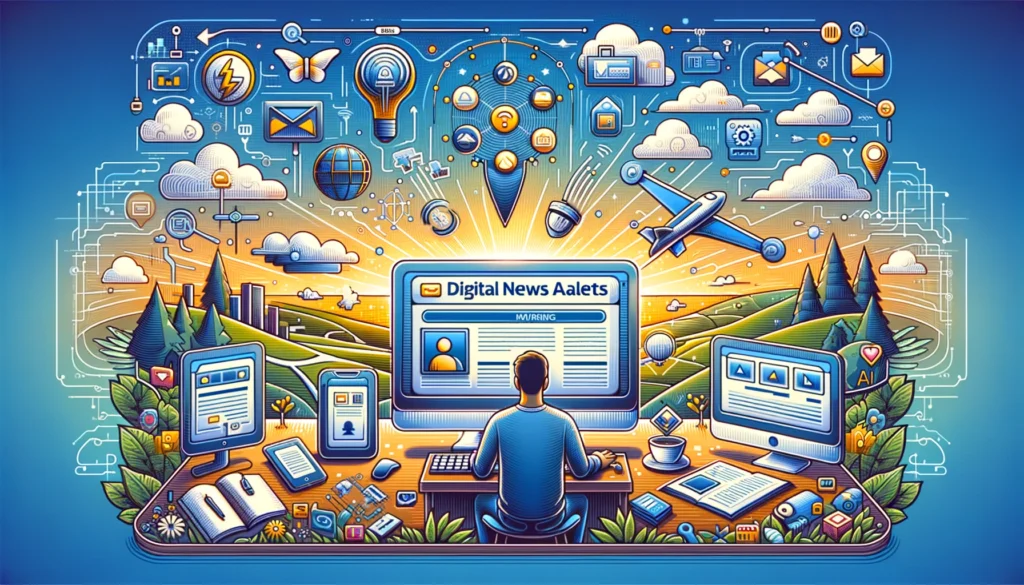In an age defined by immediacy, digital news alerts have transformed how people consume information. These concise, real-time notifications deliver breaking news directly to smartphones, tablets, and computers, enabling users to stay informed about global events as they unfold. With the proliferation of mobile devices and high-speed internet, digital news alerts have become an essential tool for modern news dissemination.

The Evolution of News Delivery
Historically, news was delivered through traditional media channels such as newspapers, radio, and television. While effective, these mediums often lagged behind real-time events. The advent of the internet and mobile technology has redefined the speed and accessibility of news. Digital news alerts emerged as a natural progression of these advancements, filling the gap between traditional reporting and the need for instant updates. Today, they are integral to platforms ranging from dedicated news apps to social media networks.
How Digital News Alerts Work
Digital news alerts are short messages sent to subscribers, often via push notifications or email, to inform them about breaking news, updates, or events of interest. They rely on algorithms and editorial oversight to determine the relevance and urgency of a story. Advanced personalization features allow users to tailor alerts based on their preferences, such as topics, geographic regions, or publication sources. This customization ensures that users receive content most relevant to them without being overwhelmed by less pertinent information.

The Benefits of Digital News Alerts:-
Real-Time Information: Digital news alerts provide immediate updates on significant events, allowing users to stay informed without actively seeking out information. This immediacy is particularly valuable during emergencies or crises, such as natural disasters, public health concerns, or political developments.
- Convenience and Accessibility: With a few taps on a mobile device, users can access critical news updates anywhere, anytime. This accessibility ensures that even those with busy schedules remain informed about key global or local events.
- Personalization: Modern digital news platforms leverage artificial intelligence to offer tailored content. Users can select specific topics, such as technology, sports, or finance, and receive alerts that align with their interests.
- Enhanced Engagement: By delivering concise and relevant updates, digital news alerts encourage users to engage more frequently with news platforms. This engagement often leads to a deeper exploration of stories beyond the headline.
- Democratization of Information:Digital news alerts make information accessible to a broader audience, bridging gaps caused by geographic or socio-economic barriers. As long as one has internet access, staying informed is possible

Challenges and Concerns
While digital news alerts offer numerous advantages, they are not without challenges.
- Information Overload: The constant stream of notifications can overwhelm users, leading to alert fatigue. When inundated with frequent updates, users may start ignoring alerts altogether, defeating their purpose.
- Credibility and Misinformation: In the race to deliver news quickly, there is a risk of disseminating unverified or inaccurate information. This problem is exacerbated by the spread of misinformation on social media platforms, which often masquerades as legitimate news.
- Privacy Concerns: To provide personalized alerts, platforms often collect user data, raising concerns about data privacy and security. Users may hesitate to share personal information, fearing misuse or breaches.
- Fragmentation of Attention: Constant interruptions from news alerts can disrupt daily routines and reduce productivity. They can also contribute to a fragmented understanding of issues, as users may only absorb headlines without delving into the full story.
- Echo Chambers: Personalized alerts, while convenient, can create echo chambers where users are only exposed to information that aligns with their existing beliefs. This selective exposure may limit diverse perspectives and contribute to polarization

Best Practices for Managing Digital News Alerts
To maximize the benefits of digital news alerts while mitigating their drawbacks, users and platforms can adopt certain best practices:
- Customize Preferences:
- Users should take advantage of personalization options to tailor alerts to their specific interests and priorities. This reduces irrelevant notifications and ensures a more meaningful experience.
- Limit Notifications: Setting boundaries on the number of alerts received can help prevent information overload. Many platforms allow users to adjust the frequency and timing of notifications.
- Verify Sources: Relying on reputable news outlets for alerts minimizes the risk of encountering misinformation. Cross-referencing stories with multiple sources can also enhance credibility.
- Use “Do Not Disturb” Features: Enabling “Do Not Disturb” settings during work hours or personal time can minimize disruptions caused by frequent notifications.
- Engage Critically: Rather than passively consuming headlines, users should strive to read full articles and seek diverse viewpoints. This approach fosters a more comprehensive understanding of complex issues.

The Future of Digital News Alerts
As technology continues to evolve, digital news alerts are poised to become even more sophisticated. Artificial intelligence and machine learning will likely play a greater role in curating content, predicting user preferences, and delivering hyper-personalized updates. Moreover, advancements in natural language processing could enable more intuitive interactions with news platforms, such as voice-activated alerts or real-time summaries.
The integration of augmented reality (AR) and virtual reality (VR) could also redefine the way news is presented. Imagine receiving an alert about a natural disaster and being able to virtually explore the affected area for a firsthand perspective. Such innovations have the potential to make news consumption more immersive and impactful.
Conclusion
Digital news alerts have revolutionized the way people stay informed, offering unparalleled speed, convenience, and personalization. However, they also come with challenges that require thoughtful management by both users and providers. By adopting best practices and leveraging technological advancements, digital news alerts can continue to enhance the way information is disseminated and consumed, fostering a more informed and connected global community.

FAQs
Digital news alerts are concise, real-time notifications sent to devices like smartphones, tablets, or computers to inform users about breaking news or significant events as they happen.
These alerts rely on a combination of algorithms and editorial oversight to determine the relevance and urgency of a story. Users can customize their preferences based on topics, geographic areas, or sources, ensuring the alerts are tailored to their interests.
Real-Time Updates: Immediate access to breaking news and critical developments.
Convenience and Accessibility: News delivered directly to your device, anytime and anywhere.
Personalization: Tailored content based on user preferences, like topics or regions.
Enhanced Engagement: Encourages users to explore news platforms and delve deeper into stories.
Democratization of Information: Makes news accessible globally, bridging geographic and socio-economic gaps.
Information Overload: Too many notifications can overwhelm users.
Credibility Issues: Risk of misinformation due to the pressure to deliver updates quickly.
Privacy Concerns: Platforms often collect user data to personalize alerts, raising security concerns.
Fragmentation of Attention: Frequent interruptions can disrupt productivity and lead to a shallow understanding of issues.
Echo Chambers: Personalization may limit exposure to diverse perspectives, reinforcing existing beliefs.
Customize Preferences: Select topics and sources that are most relevant to you.
Limit Notifications: Adjust the frequency and timing of alerts to reduce overload.
Verify Sources: Stick to reputable news outlets and cross-check information.
Use “Do Not Disturb” Features: Minimize disruptions during work or personal time.
Engage Critically: Read full articles and seek diverse perspectives for a deeper understanding.
They can be reliable if they come from reputable news platforms. However, users should verify information and cross-reference with multiple sources to ensure accuracy and avoid misinformation.







